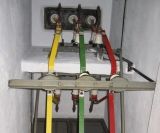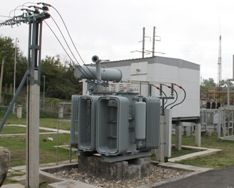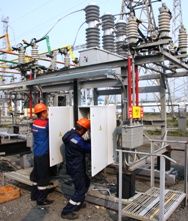Finding the ground in a network with an isolated neutral
 In electrical installations with an operating voltage of 6-35 kV with isolated neutral, in case of damage or disruption of insulation, falling wires, etc. a ground fault occurs. The single-phase earth fault mode in a network with an isolated neutral is not an emergency mode. Therefore, there will be no automatic disconnection of the damaged section from the power grid.
In electrical installations with an operating voltage of 6-35 kV with isolated neutral, in case of damage or disruption of insulation, falling wires, etc. a ground fault occurs. The single-phase earth fault mode in a network with an isolated neutral is not an emergency mode. Therefore, there will be no automatic disconnection of the damaged section from the power grid.
This mode of operation is dangerous for the insulation of the equipment, since the phase voltages in this case increase significantly. This, in turn, leads to a breakdown of the insulation and a transition from a single-phase to a two-phase earth fault.
In addition, an earth fault is very dangerous for people, in particular for service personnel (in the event of a fault on the territory of the outdoor switchgear or the indoor switchgear). At the same time, there is a high probability of an electric shock as a result of the propagation of currents to the ground (step voltage).
Therefore, the operating personnel who carry out the maintenance of the electrical installation need to remove the damage as soon as possible, that is, to determine the location of the damage.
There are several types of ground faults: metal fault, incomplete arcing fault and ground fault due to damaged insulation of live parts.
Insulation control in electrical installations 6-35 kV is carried out using:
— undervoltage relays which are connected to phase voltages VT;
— voltage relays that are included in the open delta winding;
— current relays which are connected to the output of the zero-sequence current filter;
— voltmeters for insulation monitoring.
Readings of the insulation control voltmeter:
— in case of a metallic earth fault: on the damaged phase the device shows «zero», while the voltage of the other two phases increases 1.73 times, that is, it is equal to the line voltage of the network;
— in case of earthing through the arc: on the damaged phase «zero», on other phases the voltage increases by 3.5-4.5 times;
— in the case of grounding due to reduced insulation resistance, the readings of the insulation control voltmeter are asymmetrical. The so-called "imbalance" of the mains phases occurs.
 Depending on the implemented insulation monitoring scheme, an "earth fault" signaling is carried out with an indication of a specific damaged phase or no phase detection. In the latter case, the damaged phase is determined by the readings of the kilovoltmeters for monitoring the insulation of one or another section of the network.It is necessary to record the readings of the insulation monitoring voltmeters in both cases.
Depending on the implemented insulation monitoring scheme, an "earth fault" signaling is carried out with an indication of a specific damaged phase or no phase detection. In the latter case, the damaged phase is determined by the readings of the kilovoltmeters for monitoring the insulation of one or another section of the network.It is necessary to record the readings of the insulation monitoring voltmeters in both cases.
It also has a false ground signal trigger.
Let's list the main reasons for false triggering of the ground signal in the 6-35 kV network:
— a significant difference in the capacities of the phases relative to the ground;
— incomplete phase disconnection of the transformer;
— connection to a network section of another uncompensated network section, including automatic (working with ATS);
— phase break (blown fuse) on the LV or LV side of the power transformer. In this case, there will be a slight voltage imbalance;
— phase failure (blown fuses, tripping of a circuit breaker or other cause) of a voltage transformer, which is designed to control the isolation of this section of the network. In the event of a phase failure on the LV side, one phase will show zero, and the other two voltage phases. In the event of a high-side (HV) phase failure, the readings of the insulation monitoring devices will be asymmetrical. At the same time, it is difficult to determine whether the fuse has blown or not according to the readings of the instruments, since the distortion is insignificant.
Consider the case of a slight phase imbalance (false triggering of a ground signal). When the fuse on the high side of VT blows, a ground signal appears briefly, after which a slight unbalance of the phase and line voltages is observed. The reason for this unbalance may be the excellent capacitances of the phases with respect to earth, unbalanced user load.
In this case, you can try to sequentially disconnect the connections that are powered by this section of the network (section or bus system). If the readings of the insulation monitoring devices do not change, then there is a high probability that the cause of such a voltage imbalance is a blown fuse on the HV side of the voltage transformer.
Actions of the service personnel of the electrical installation to find the place of the short circuit to the «ground».
 Finding a single-phase short circuit is carried out using a special device or by the method of alternate shutdowns. In this case, an alternative disconnection of the connections powered by the section of the bus (system) is carried out, where VT indicates the presence of faults, as well as the connection of sections of the electrical network that is electrically connected to this bus (system).
Finding a single-phase short circuit is carried out using a special device or by the method of alternate shutdowns. In this case, an alternative disconnection of the connections powered by the section of the bus (system) is carried out, where VT indicates the presence of faults, as well as the connection of sections of the electrical network that is electrically connected to this bus (system).
If after breaking the line, the grounding signal disappeared, it means that there was a short circuit to ground on this line. This connection can only be put into operation after the cause of the single-phase short circuit has been determined.
If the damaged section cannot be found by the method of alternate interruptions of the outgoing connections, then all connections of the network section where the "earth" appeared must be disconnected, make sure that the signal of a single-phase short circuit has been eliminated. Then you need to turn on the outgoing connections one by one. If the switching on of one of the output lines coincides with the occurrence of a ground signal, this connection must be disconnected and not put into operation until the reason for triggering the ground signal is clarified.
Accordingly, if a "ground" occurs when a repair link has previously been engaged, that link must be broken immediately.
There are also situations where when all output lines are disconnected, the ground signal is not eliminated. This indicates that a substation equipment failure has occurred, for example in the area from the power transformer to the busbar section inclusive. First of all, it is necessary to determine whether the fault is on the bus section or on other equipment (main switch, bus from the power transformer to the main switch).
To do this, turn off the input switch of this section, turn on the switch of the section. If a "grounded" signal appears in the section to which this section of the network is connected, then the fault is in the bus section. The damaged section must be taken out for repair to repair the damage.
If there is no "earth" signal, then the fault is located in the section from the power transformer to the section input switch. In this case, it is necessary to check the equipment of this section of the switchgear for damage. If the reason for the "earth" is insulation failure, then it will most likely not be possible to detect the damage visually.
To find the fault, it is necessary to take this section of the switchgear for repair. Determining an insulation defect is carried out through electrolaboratory tests of the equipment.
